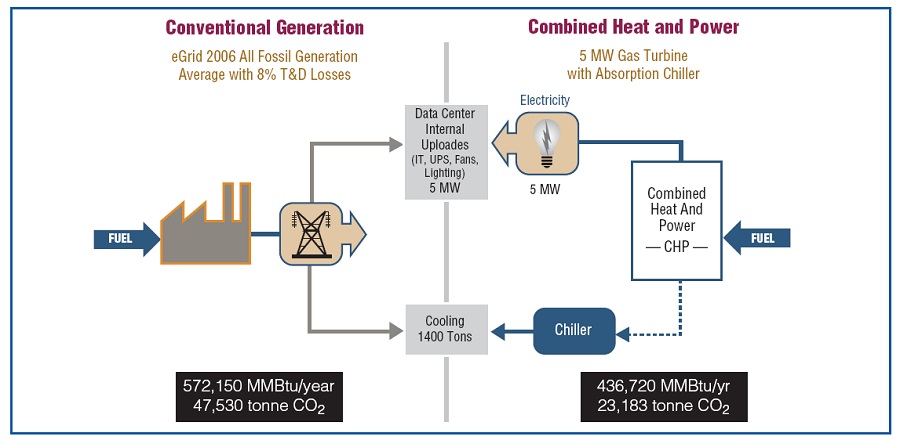Reliable power is the lifeblood of a data center, and power outages can put a stranglehold on data center operations. Add to that mix the high cost of energy, grid congestion and an increased focus on energy efficiency — and data centers in the New York metro area have a reason to explore alternative means to obtain power.
Combined Heat and Power (CHP) systems offer one solution to boost both reliability and energy efficiency, since CHP can be used to produce power and augment cooling requirements in the data center. CHP also increases overall fuel efficiency, reduces grid congestion and decreases energy costs by making use of the waste heat from on-site electricity production. A comparison between conventional grid-generated power and CHP is depicted in Figure 1.
Some of the benefits of CHP include:1
- Reduced Energy Usage: Data centers have high electricity demands and costs. Installing CHP systems with absorption cooling can reduce energy costs by producing power inexpensively on-site, while waste heat from the generation of power can then be used in absorption chillers to offset cooling load on electrical chillers. In addition, CHP systems have lower transmission and distribution losses (~5% to 8% when compared to conventional grid-generated power at a central power plant.
- Improved Reliability: Data centers require reliable, high-quality power. Since CHP provides on-site electricity generation, it is resilient in the face of grid outages while protecting against long-term outages beyond what UPS and battery systems can provide; increased reliability also means reduced battery backup requirements.
- Enhanced Facility Expansion: Developing on-site power sources gives data center operators increased scheduling flexibility to expand or design new facilities. Upgrading older, smaller data centers with new equipment can require a large increase in power demand that the utility cannot meet immediately. Minimizing external power demand also reduces additional utility infrastructure requirements for new or expanded facilities.
- Reduced Emissions: High energy needs in data centers consequently result in greater emissions of pollutants such as CO, NOX, and SO2 from power plants supplying the power. When considering source-to-site emissions, CHP systems reduce emissions of criteria air pollutants through increased efficiency and cleaner technologies.
CHPs are typically deployed as a layer on top of the existing power and cooling infrastructure, to work in tandem with utility power and electrical chillers. A data center typically has two or three power sources: primary power from the CHP system, back-up power from the utility feed through the UPS system, and a second back-up of highly critical applications from a second utility feed or standby diesel generators2.
The CHP system provides chilled water through an absorption chiller, which is backed upby one or more back-up electric chillers thatdraw power fromthe critical load panel3. When CHP is in operation, the absorption chillers support the majority of the cooling load, while electrical chillers supplement the cooling load balance. As a rule of thumb, a 1 megawatt (MW) CHP plant can provide approximately 275 tons of cooling using absorption chillers, which can offset a major portion of the data center cooling load and result in significant mechanical system energy savings.
CHP has high operational availability, is more cost effective and less polluting than power purchased from utility providers. Willdan has worked with several clients to evaluate the feasibility of CHP projects for their data centers. With a typical payback of period of four to five years and generous incentives available for CHP deployment in NYC data centers, coupled with demand-response program participation revenue, CHP systems are a viable alternative offering reliable power, revenue stream, and energy savings.
1. Combined Heat and Power – Energy Savings and Energy Reliability for Data Centers, USEPA Partnership, October 2008.
2. Darrow, K, et al. 2009. Opportunities for Combined Heat and Power in Data Centers, ICF International.
3. ibid


Recent Comments
Risk Assessment for Data Centres
All wrapped up perfectly.